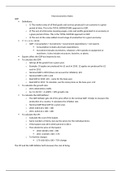Case
MACROECONOMICS STUDY GUIDE Latest Update 2020
- Course
- EC 13203
- Institution
- Boston College
Macroeconomics Notes GDP • Definitions: o 1) The market value of all final goods and services produced in an economy in a given period of time. This is the TOTAL EXPENIDTURE approach to GDP. o 2) The sum of all incomes meaning wages, rents and profits generated in an economy in a given period...
[Show more]



